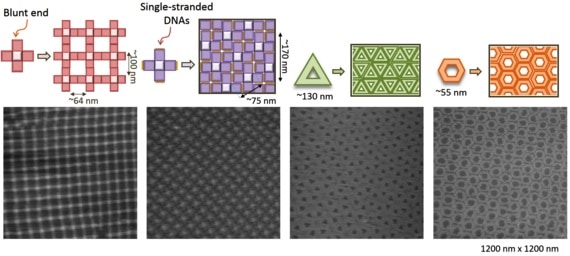
The frequent improvements and extensions of scaffolded DNA origami testify to the usefulness of this technology. A hat tip to KurzweilAI for reporting this advance from Kyoto University organizing DNA origami nanostructures into micrometer-scale 2D arrays “Using DNA origami to build nanodevices of the future“:
Scientists have developed a method, using a double layer of lipids, which facilitates the assembly of DNA origami units, bringing us one-step closer to organized DNA nanomachines.
Scientists have been studying ways to use synthetic DNA as a building block for smaller and faster devices. DNA has the advantage of being inherently “coded”. Each DNA strand is formed of one of four “codes” that can link to only one complementary code each, thus binding two DNA strands together. Scientists are using this inherent coding to manipulate and “fold” DNA to form “origami nanostructures”: extremely small two- and three-dimensional shapes that can then be used as construction material to build nanodevices such as nanomotors for use in targeted drug delivery inside the body.
Despite progress that has been made in this field, assembling DNA origami units into larger structures remains challenging.
A team of scientists at Kyoto University’s Institute for Integrated Cell-Material Sciences (iCeMS) has developed an approach that could bring us one step closer to the organized nanomachines of the future.
They used a double layer of lipids (fats) containing both a positive and a negative charge. DNA origami structures were weakly absorbed onto the lipid layer through an electrostatic interaction. The weak bond between the origami structures and the lipid layer allowed them to move more freely than in other approaches developed by scientists, facilitating their interaction with one another to assemble and form larger structures.
“We anticipate that our approach will further expand the potential applications of DNA origami structures and their assemblies in the fields of nanotechnology, biophysics and synthetic biology,” says chemical biologist Professor Hiroshi Sugiyama from iCeMS.
The research was published as an Open Access paper in Nature Communications “Lipid-bilayer-assisted two-dimensional self-assembly of DNA origami nanostructures“. The authors note in their discussion that several methods exist for origami nanostructures to self-assemble into 2D lattices including blunt-end stacking and close-packing of triangles and hexagons. They also express their optimism that it will be possible to organize even dynamic systems like molecular motors and enzymatic cascase reactions on origami nanostructures, and then arrange them into more sophisticated hierarchical structures. Near-term applications in nanomaterials and other areas of nanotechnology, biophysics, and synthetic biology seem likely; whether these could eventually be extended toward high-throughput atomically precise manufacturing remains an open question.
—James Lewis, PhD

